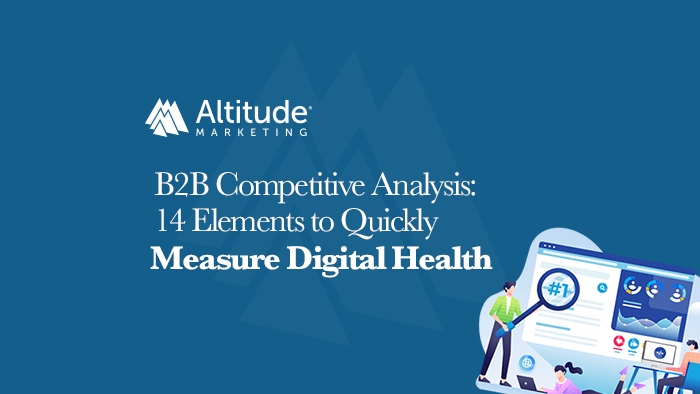Having a beautiful website and strong brand is great. But it just isn’t enough for today’s marketers. You need to know how you stack up against the market. That’s where a B2B competitive analysis comes in.
Do your tactics work? Do they work better than your competition? Can prospects find you? And when they do, will they convert?
In 2015, 71% of B2B customers started their research with a Google search. That number has only gone up. And that’s why it’s useful to focus your B2B competitive analysis on your – and your competitors’ – digital footprint.
Here’s how to run a digital health checkup.

What is a B2B Competitive Analysis?
B2B competitive analysis evaluates your competition against several indicators to better understand their strengths and weaknesses.
The end goal is to outflank your competition. You can only do that if you know how (if) they are reaching buyers.
Typical B2B competitive analyses include a brand audit that evaluates the messaging and positioning of known competitors.
Some of these brand measures include:
- Brand personality & reputation
- Brand messaging
- Features
- Primary & secondary audiences
That’s all incredibly important stuff. But what about your brand’s digital health? Online, competition can come from many different directions. Seeing how you stack up against search-specific competitors (in other words, those that show up on Google search results when searching for terms related to you) are just as important as competitors you often run into (or up against) IRL.
Your website is home base for your brand and needs to stand out from the crowd. So, in addition to the more qualitative measures above, it’s important to analyze a few key measurements of digital health.
Here’s how it’s done.
How to Conduct a B2B Competitive Analysis for Digital Health
This process, with a focus on the measurements of digital health, can be boiled down into a few easy steps.
Tip #1: Identify Competitors
There are two primary sources of competition: The ones you know about and the ones that appear in the digital landscape.
First, write down the competitors you regularly run into.
Then, search a key brand term on Google and see who comes up. Those are your “search-specific” competitors. There will likely be some overlap between the competitors you already know about and the search-specific ones. But don’t be surprised if new names pop up, too.
#2. Measure Digital Health for You & Your Competition
Simply follow the checklist below for your own company, and then compare your results to your competition.
Most of the answers can be covered by tools like Google Analytics, Lighthouse, Moz and SpyFu.
Others might require a little more digging – or some help from experts who conduct B2B competitive analyses on the regular.
14 Measurements of Digital Health
You can use the following list as a checklist to measure your website and other important digital aspects against your competition.
- Performance: The speed and quality of load. User experience matters to Google, and load time is a drag. So, site performance can impact how Google rates your site. Plus, the longer it takes your site’s relevant content to load, the more likely potential prospects will bail.
- Accessibility: Is there anything preventing visitors from accessing your site regardless of physical, situational or socio-economic limitations?
- Technical SEO: Is your site technically discoverable per best practices as measured by Google?
- Marketing Automation: Do your competitors use a marketing automation platform, and which one? Lack of MAP is usually a sign of a less-than-mature digital marketing strategy.
- CMS: Different content management systems are good for different goals. See what your competitors think is important by looking at what CMS they’ve chosen.
- SSL Certificate: An SSL certificate is table stakes in this day and age. No SSL is a major red flag.
- Domain Authority: An indicator of a domain’s “authority,” derived largely from its age, content depth and backlink portfolio. Higher is better and allows the site to rank for more keywords.
- External Backlinks: The number of organic backlinks pointing to a site. More is better, although the ratio of backlinks to referring domains should be roughly 7:1 or less.
- Referring Domains: The number of domains linking to a site. More is better. Too many links from too few domains can be a sign of inorganic (and unsustainable) link building practices.
- .edu & .gov Domains: The number of .edu and .gov domains linking to a site is huge in a B2B competitive analysis. These are WILDLY valuable as Google rates educational and governmental sites (and those they link out to) as exceptionally authoritative. More is better.
- Organic Keywords: The number of keywords the domain currently ranks for. More is better but quantity isn’t everything. Look at how often competitors are one page one—and for what.
- Estimated Monthly PPC Spend: The amount of money a site spends each month on pay-per-click search ads. If competitors are all investing heavily and you’re not — or vice versa — it bears investigating.
- Google Remarketing: Does the site have Google remarketing tags in place? A “no” in this column is a sign of lack of sophistication. Remarketing is a simple way to stay in front of visitors and often results in a much higher CTR than a display ad campaign.
- Mobile Friendly: Table stakes. A “no” here is a huge red flag that your site or that of a competitor needs a serious overhaul.
Conclusion
A B2B competitive analysis is one of the first things you should do before you make any major decisions about your brand’s direction. Why? Marketing strategies must be developed based on real-world data. Otherwise, they’re just a shot in the dark—and they won’t work.
Before you can understand how to position yourself in the marketplace and create the right messaging and tactics, you have to first understand what your competitors are doing.
With these measurements of digital health in mind, you will be able to grow and strengthen your digital presence. Improving organic search visibility and implementing a strategic integrated marketing program will help you create a stronger lead funnel, get you in front of more prospects and capture more market share.
But one more quick thing: Getting prospects to your website is only the first step. Do they stay there? Do they convert? As you look to improve your digital presence, make sure you also have optimized your website for conversions.
Now, go get ‘em!



